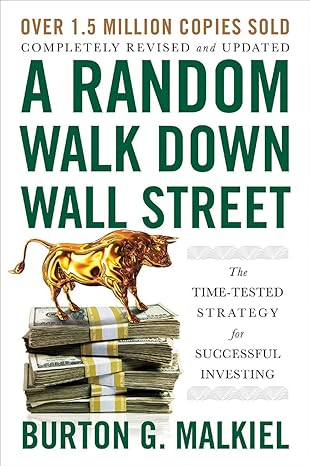Main Topic
“A Random Walk Down Wall Street” by Burton G. Malkiel explores the concept of efficient market hypothesis (EMH) and advocates for passive investing through index funds. The main theme revolves around guiding investors in making informed decisions in the stock market.
Key Ideas or Arguments
- Efficient Market Hypothesis (EMH): Malkiel introduces the EMH, which suggests that stock prices reflect all available information and, therefore, it’s challenging to consistently beat the market through stock picking or market timing.
- Random Walk Theory: The book discusses the concept of a “random walk,” where stock prices follow a random pattern, making it difficult to predict future price movements accurately.
- Passive Investing: Malkiel argues that investors should focus on passive investing strategies, like investing in low-cost index funds, as these offer better long-term returns compared to actively managed funds.
- Diversification: The book emphasizes the importance of diversifying one’s investment portfolio to reduce risk. Malkiel advises spreading investments across various asset classes.
- Behavioral Finance: Malkiel delves into the psychology of investors and how emotions can lead to irrational decision-making. He encourages readers to avoid common behavioral pitfalls.
Chapter Titles or Main Sections with a Paragraph on Each
- The Firm Foundations: This section provides an introduction to the stock market and the concept of EMH.
- The Investor and Market Fluctuations: Malkiel discusses various investor behaviors and the impact of market fluctuations.
- How the Pros Play the Biggest Game in Town: This chapter explores the strategies of professional investors and how they often underperform the market.
- Technical and Fundamental Analysis: The book explains the limitations of technical and fundamental analysis in predicting stock prices.
- The Madness of Crowds: Malkiel discusses how speculative bubbles and crowd behavior can affect the market.
- The Most Personal Investment: This section focuses on personal finance and retirement planning.
- A Practical Guide for Random Walkers and Other Investors: The author offers practical advice on constructing a diversified investment portfolio and the benefits of passive investing.
Key Takeaways
- Efficient Market Hypothesis suggests that it’s challenging to outperform the market consistently.
- Passive investing through index funds can provide more reliable long-term returns.
- Diversification is crucial for reducing risk in one’s investment portfolio.
- Behavioral factors often lead to irrational investment decisions.
- Speculative bubbles and market irrationality can impact investment outcomes.
Author’s Background and Qualifications
Burton G. Malkiel is an esteemed economist and academic. He is a professor of economics at Princeton University and has held various advisory roles in the financial industry. His expertise in economics and finance makes him a credible authority on the subject.
Comparison to Other Books
Malkiel’s book is often compared to other investing classics like “The Intelligent Investor” by Benjamin Graham. While Graham’s book focuses on value investing, Malkiel’s approach is more aligned with passive investing and EMH. Both provide valuable perspectives on investing.
Target Audience
This book is suitable for novice and experienced investors looking for a comprehensive understanding of stock market dynamics, investment strategies, and the principles of passive investing. It is an accessible guide for anyone interested in managing their investments.
Reception or Critical Response
“A Random Walk Down Wall Street” has received widespread acclaim for its clarity and timeless advice. It is considered a foundational work in the field of investing and is highly regarded by both experts and the general public.
Publisher and First Published Date
The book was published by W.W. Norton & Company and was first published in 1973.
Recommendations
- “The Intelligent Investor” by Benjamin Graham.
- “The Little Book of Common Sense Investing” by John C. Bogle.
- “The Millionaire Next Door” by Thomas J. Stanley and William D. Danko.
Biggest Takeaway
The book’s primary takeaway is that investors should consider passive investing through low-cost index funds, as the efficient market hypothesis suggests it’s challenging to consistently beat the market through active stock picking and market timing.



